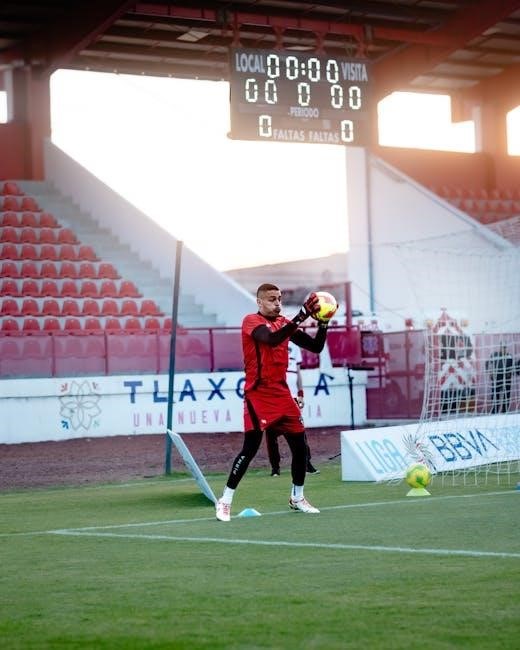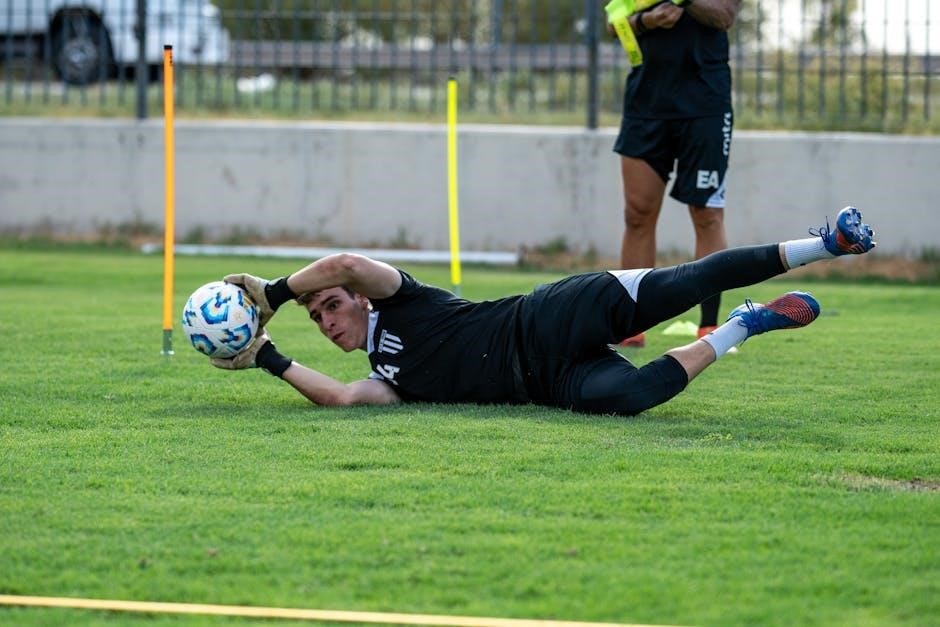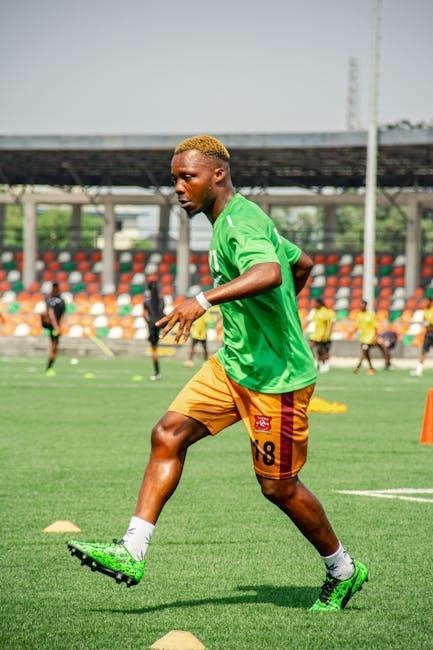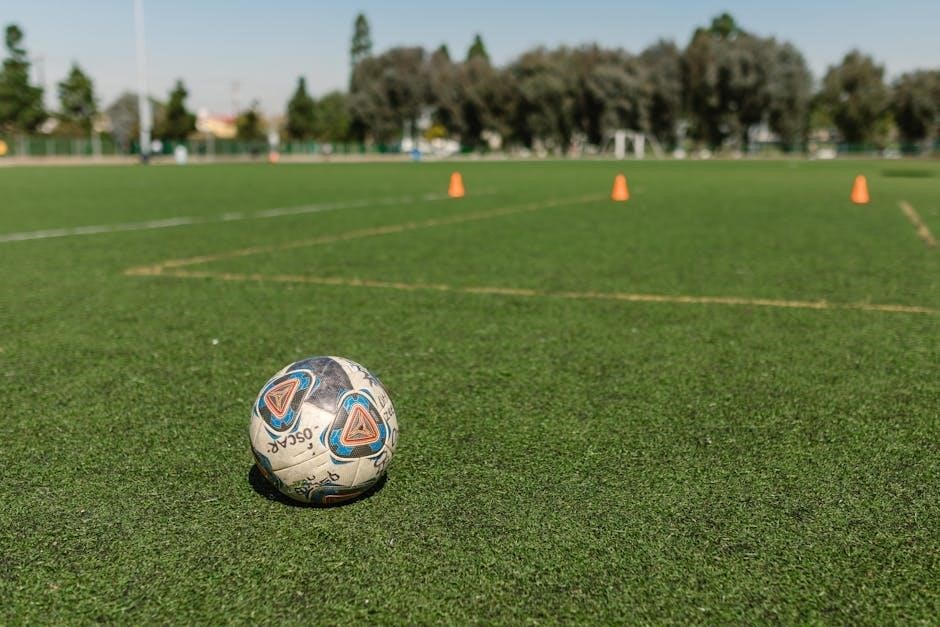
Football training drills are essential for enhancing performance, focusing on stamina, strength, agility, and technical skills. These structured exercises help players improve efficiency and adaptability, from beginners to advanced levels. Drills cover physical conditioning, tactical awareness, and teamwork, ensuring comprehensive development for modern football demands.
Importance of Consistent Training in Football
Consistent training is vital for achieving and maintaining a high level of performance in football. It enhances stamina, strength, and overall fitness, enabling players to meet the demands of the game. Regular practice improves technical skills, tactical awareness, and teamwork, while also reducing the risk of injuries. Over time, consistent training builds mental toughness and discipline, which are critical for success. Players who commit to regular drills and exercises experience steady progress, ensuring they remain competitive and adaptable to the evolving nature of the sport.
Overview of Training Drills for Skill Development
Training drills for skill development in football are designed to enhance technical abilities, tactical awareness, and physical performance. These exercises focus on improving ball control, passing accuracy, shooting precision, and dribbling techniques. Drills also emphasize agility, speed, and stamina, ensuring players can perform at peak levels during matches. From basic exercises like cone weaving to advanced moves such as step-overs, these drills cater to all skill levels. Consistent practice helps players master fundamentals, adapt to game situations, and develop the confidence needed to excel on the field. Regular engagement with these drills fosters overall improvement and prepares athletes for competitive play.

Stamina and Endurance Training
Stamina and endurance are vital for football, as players cover over 10km per match. Training includes long-distance runs, sprint intervals, and HIIT to build lasting energy and explosive power.
Long-Distance Running for Building Stamina
Long-distance running is a cornerstone of stamina development in football. Players typically cover over 10km in a 90-minute match, making endurance crucial. This drill involves sustained runs of 3-5 miles at a steady pace, improving cardiovascular fitness and muscular endurance. Incorporating interval runs and gradual increases in distance enhances adaptability. Proper warm-up and hydration are emphasized to prevent injuries and optimize performance. This foundational training ensures players maintain energy levels throughout the game, enabling consistent efforts during intense matches. Consistency and gradual progression are key to achieving peak stamina levels.
Sprint Intervals for Explosive Power
Sprint intervals are a key component of football training, designed to boost explosive power and acceleration. These drills involve short bursts of maximum-effort running, typically lasting 20-50 meters, followed by brief recovery periods. Repetitions are repeated for 15-30 minutes, enhancing speed and energy output. This training mimics match scenarios, where quick sprints are essential for outpacing opponents. Incorporating hill sprints can further strengthen leg muscles and improve power. Proper warm-up and cool-down are crucial to prevent injuries. Sprint intervals not only enhance physical performance but also mental resilience, preparing players for high-intensity game situations. Consistency in this drill yields significant improvements in explosive power and agility.
High-Intensity Interval Training (HIIT)
High-Intensity Interval Training (HIIT) is a highly effective method in football training, combining short bursts of intense activity with brief recovery periods. This format mirrors the intermittent nature of football, where players alternate between sprints, runs, and pauses. HIIT workouts, such as 30 seconds of all-out sprinting followed by 1-2 minutes of rest, enhance cardiovascular fitness, speed, and endurance. Regular HIIT sessions improve a player’s ability to recover quickly between plays, boosting overall performance. It also increases mental toughness and focus, as players push through intense efforts. Incorporating HIIT into a training regimen is a time-efficient way to achieve significant gains in fitness levels, making it a cornerstone of modern football preparation.

Strength Training for Football
Strength training is vital for football, enhancing power, speed, and injury resilience. It focuses on building muscle and improving overall physical robustness, essential for both offensive and defensive plays.
Resistance Band Exercises
Resistance band exercises are a versatile and portable tool for strength training in football. They target multiple muscle groups, enhancing muscular endurance and power. Ideal for pre-season training, bands improve flexibility and reduce injury risk. Players can perform exercises like banded squats, chest presses, and lateral walks to build stability and explosive force. Their lightweight design makes them perfect for both home and field use, ensuring consistent training even without heavy equipment. Incorporating bands into routines boosts overall strength, vital for maintaining performance throughout matches and training sessions.
Weightlifting for Muscle Development
Weightlifting is crucial for building muscle mass and power, essential for football players. It enhances strength, speed, and resilience, allowing athletes to dominate on the field. Key exercises include squats, deadlifts, and bench presses, which target major muscle groups. Proper form is vital to prevent injuries. Weightlifting also improves bone density and overall physical stability. A structured program ensures balanced development, addressing specific muscle groups needed for explosive movements and endurance. This foundational strength translates into better performance during matches and training, making it a cornerstone of any effective football training regimen.
Plyometric Exercises for Explosiveness

Plyometric exercises are designed to boost explosiveness and power, critical for football players. These dynamic movements, such as box jumps, burpees, and jump squats, enhance muscle activation and acceleration. By focusing on rapid, powerful contractions, plyometrics improve leaping ability and sprinting speed. Incorporating these drills into a training routine enhances overall athleticism, enabling players to excel in high-intensity situations. Proper form and gradual progression are essential to avoid injury and maximize benefits, making plyometrics a key component of advanced football training programs aimed at developing explosive power and agility.

Agility and Speed Drills
Agility and speed drills enhance quick movements, sharp turns, and rapid acceleration, crucial for football. These exercises improve coordination and reaction time, boosting overall performance on the field.
Cone Drills for Sharp Turns and Quick Changes
Cone drills are effective for improving agility and quick directional changes. Players weave through cones with sharp turns, enhancing balance and speed. These exercises simulate game scenarios, improving reaction time and control. Drills vary in complexity, from simple zigzags to intricate patterns, challenging players to maintain precision at high speeds. Incorporating cones into training helps develop the ability to change direction swiftly, a key skill in football for evading opponents and creating scoring opportunities. Regular practice builds confidence and reflexes, making players more dynamic on the field.
Ladder Drills for Foot Speed and Coordination
Ladder drills are excellent for enhancing foot speed, coordination, and overall agility. These exercises involve quick movements through a ladder, such as high knees, lateral shuffles, and carioca drills; Players perform rapid steps, focusing on precision and rhythm, which improves their ability to accelerate and decelerate effectively. The drills are versatile, with variations like alternating feet and changing directions, making them suitable for all skill levels. Regular practice with ladder drills boosts a player’s reaction time and coordination, essential for outpacing opponents and maintaining control during fast-paced game situations. This training is fundamental for developing the agility needed in modern football.
Shuttle Runs for Acceleration and Deceleration
Shuttle runs are dynamic drills designed to boost acceleration, deceleration, and reaction time. Players set up cones or markers 10-20 meters apart and perform rapid sprints forward, then quickly decelerate and backpedal to the starting point. This exercise mimics match scenarios where quick changes in direction are crucial. Variations include zigzag patterns or adding turns to enhance agility. Shuttle runs improve explosive power and control, enabling players to outpace opponents and maintain balance during sharp movements. Regular practice enhances overall speed and responsiveness, making it a key component of football conditioning programs. This drill is versatile and effective for players at all skill levels, focusing on both speed and precision.

Ball Control and Dribbling Drills
Ball control and dribbling drills focus on mastering close ball contact, precision, and agility. These exercises improve a player’s ability to maintain possession and navigate tight spaces effectively;
Basic Dribbling Techniques
Mastering basic dribbling techniques is fundamental for any football player. These exercises focus on ball control using different parts of the foot, such as the inside, outside, and sole. Players practice maintaining low center of gravity, keeping the ball close, and using small, quick touches to manipulate the ball’s direction. Drills often involve stationary exercises like figure-eight runs and cone weaving to enhance coordination and ball familiarity. As players progress, dynamic movements and changes of direction are introduced to simulate game-like scenarios, ensuring smooth transitions from basic to advanced dribbling skills seamlessly.
Cone Weaving for Precision
Cone weaving is a fundamental drill to enhance ball control and precision. Players navigate the ball through a series of cones arranged in a straight line or zigzag pattern. The objective is to maintain close contact with the ball while executing sharp turns and quick directional changes. Proper footwork, balance, and focus are emphasized to ensure smooth transitions. This exercise improves agility, coordination, and the ability to maintain possession in tight spaces. Variations include increasing speed, altering cone layouts, and incorporating dynamic movements to simulate match scenarios, making it an effective tool for refining technical skills and overall ball mastery.
Advanced Dribbling Moves (Step-Overs, Feints)
Advanced dribbling moves like step-overs and feints are crucial for outsmarting opponents. Step-overs involve faking a move in one direction while maintaining possession. Feints are deceptive body movements that mislead defenders. These techniques require precision, balance, and timing. Start with slow, controlled executions, focusing on selling the fake with body language and head movements. Gradually increase speed to match game-like conditions. Incorporate these drills into training to enhance offensive versatility and confidence. Mastery of step-overs and feints allows players to create space,beat defenders, and dictate the flow of the game, making them indispensable tools for any aspiring offensive player seeking to elevate their skill set.

Defensive Training Drills
Defensive training drills focus on building resilience, positioning, and reaction skills. These exercises enhance players’ ability to read the game, anticipate threats, and execute effective tackles and clearances.
Defensive Positioning and Awareness
Defensive positioning and awareness are critical for anticipating opponents’ moves and protecting the goal. Drills emphasize spatial recognition, reading the game, and maintaining defensive shape. Players learn to identify threats, adjust positioning, and communicate effectively. These exercises simulate match scenarios, improving decision-making under pressure. Proper positioning reduces vulnerabilities, allowing defenders to intercept passes and block shots effectively. Awareness drills often involve small-sided games and simulations to mirror real-game situations, ensuring defenders are proactive rather than reactive. Enhanced positioning and awareness lead to a more solid and organized backline, crucial for any successful team. Regular practice strengthens these instincts, making defenders more reliable and proactive.
Sliding Tackle Practice
Sliding tackle practice is vital for developing defensive skills, focusing on timing, balance, and control. Drills involve approaching a ball carrier at an angle, using the instep or side of the foot to win possession safely. Proper technique prevents injuries and fouls, emphasizing staying low, extending the leg, and recovering quickly. Players practice sliding on both legs, improving agility and reaction time. Controlled exercises, such as cone drills and one-on-one scenarios, simulate game situations, helping defenders master the art of the slide tackle. Effective sliding tackles can disrupt opponents and regain possession, making them a crucial defensive tool in football. Regular practice builds confidence and proficiency in this essential skill, enhancing overall defensive capabilities and ensuring safety for both players involved. These drills are integrated into training routines to refine technique and decision-making under pressure, making defenders more effective and reliable during matches. With consistent practice, players develop the instincts to execute sliding tackles precisely and confidently, contributing to a stronger defensive line and better overall team performance. Sliding tackle drills are a cornerstone of defensive training, equipping players with the skills to compete at higher levels while minimizing the risk of injury. By focusing on proper form and game-like scenarios, these exercises prepare defenders for the challenges of competitive football, ensuring they can execute sliding tackles effectively and responsibly. The ability to perform a well-timed slide tackle can be the difference between winning and losing possession, making it a fundamental skill for any aspiring defender; Through repetitive practice and feedback, players refine their technique, becoming more adept at reading the game and anticipating opponents’ movements, which is critical for success in modern football.
Small-Sided Games for Defensive Shape
Small-sided games are invaluable for refining defensive organization and shape. These drills, often 3v3 or 4v4, simulate real match scenarios, allowing defenders to practice maintaining compactness and coordination. Players learn to read the game, anticipate opposition movements, and communicate effectively. The reduced field size accelerates decision-making, ensuring quick reactions to attacks. Coaches can incorporate constraints, like limited touches or specific zones, to focus on particular defensive aspects. These exercises enhance spatial awareness, defensive positioning, and teamwork, fostering a cohesive unit capable of adapting to varied attacking strategies. Regular practice in small-sided games sharpens defenders’ instincts, enabling them to protect the goal more effectively and contribute to overall team success.

Offensive Training Drills
Offensive drills focus on improving attacking skills, ball control, and teamwork. These exercises emphasize precision passing, strategic plays, and effective goal scoring, enhancing players’ ability to break defenses cohesively.
Passing Accuracy Drills
Passing accuracy drills are fundamental for developing precise ball distribution. Players practice short and long passes, emphasizing proper foot placement and body positioning. Wall passes and cone setups enhance control and vision. These exercises improve decision-making, timing, and teamwork, ensuring players can deliver the ball effectively under pressure. Drills like give-and-go and one-twos simulate game scenarios, refining accuracy in dynamic situations. Coaches often incorporate small-sided games to apply these skills in real-time. Regular practice builds confidence, allowing players to execute precise passes consistently, a critical skill for maintaining possession and creating scoring opportunities during matches.
Shooting Practice (Power and Precision)
Shooting practice is vital for scoring goals effectively. Drills focus on striking technique, aiming, and power. Players practice shooting from various distances and angles, improving accuracy and strength. Cone setups and small targets challenge precision, while volleys and half-volleys enhance reaction and timing. Incorporating defenders adds realism, simulating game-like pressure. Coaches emphasize proper foot placement, body balance, and follow-through to maximize efficiency. Regular practice builds confidence, enabling players to score consistently. Combining power and precision drills ensures versatility in front of goal, making shooters a threat in any situation during a match.
Attacking Strategies and Combinations
Attacking strategies and combinations are crucial for breaking down defenses and creating scoring opportunities. Drills focus on teamwork, coordination, and tactical awareness. Players practice passing sequences, overlapping runs, and wall passes to exploit defensive gaps. Small-sided games simulate match scenarios, encouraging quick decision-making and adaptability. Advanced drills incorporate multiple attackers, promoting fluid movement and interchange of positions. These exercises enhance offensive versatility, allowing players to execute plays seamlessly. By mastering these strategies, teams can dominate possession and outmaneuver opponents, leading to consistent goal-scoring opportunities. Effective attacking combinations are key to success in modern football, requiring precision, timing, and teamwork.

Goalkeeping Training Drills
Goalkeeping drills focus on improving reflexes, handling, and distribution. These exercises enhance a goalkeeper’s ability to protect the net and communicate effectively with the team, ensuring strong defensive organization and quick transitions from defense to attack. Regular practice of these drills is vital for maintaining peak performance and confidence in high-pressure situations.
Handling and Catching Techniques
Handling and catching techniques are fundamental for goalkeepers to securely claim and control the ball. These drills focus on improving grip strength, body positioning, and confidence. Goalkeepers practice catching high balls, low shots, and crosses, emphasizing the use of fingertips and body alignment. Proper technique involves cushioning the ball with the hands and bringing it safely to the chest. Drills often include gloveless catching to enhance finger strength and precision. Regular practice helps reduce errors and builds the ability to distribute the ball effectively, making the goalkeeper a reliable last line of defense and a key player in initiating attacks. Precision is vital in these exercises to ensure consistency and reliability during matches.
Reflex and Reaction Training
Reflex and reaction training is crucial for goalkeepers to respond swiftly to unpredictable situations. Drills involve quick movements, such as diving for unexpected shots or reacting to deflections. Goalkeepers practice catching reaction balls, which are designed to bounce erratically, improving hand-eye coordination. These exercises simulate game scenarios, enhancing the ability to read the play and anticipate opponents’ moves. Reaction time is further tested with rapid-fire shots from different angles, forcing the goalkeeper to explode into action. Incorporating agility ladder drills and plyometric exercises also boosts explosiveness. This training ensures goalkeepers can make split-second decisions, reducing reaction time and improving overall performance during high-pressure moments in a match. Consistency in these drills builds confidence and sharpens instincts, making goalkeepers more reliable in critical situations. Regular practice is essential to maintain and enhance these reflex skills, as they are vital for preventing goals and securing clean sheets. The combination of physical and mental training ensures goalkeepers are prepared for any situation, making them a cornerstone of the team’s defense. By focusing on reflexes, goalkeepers can develop the ability to make incredible saves and inspire their teammates with their agility and quick thinking. This aspect of training is indispensable for any aspiring goalkeeper, as it directly impacts their effectiveness on the field. Through dedicated practice, goalkeepers can master the art of reacting swiftly and confidently, becoming a key asset to their team. The drills are designed to push the goalkeeper’s limits, ensuring they are always ready to perform at their best. In conclusion, reflex and reaction training is a fundamental component of a goalkeeper’s regimen, essential for excelling in modern football.
Cross Catching and Distribution
Cross catching and distribution are vital skills for goalkeepers, enabling them to confidently claim and distribute the ball. Drills focus on positioning, timing, and handling high and low crosses. Goalkeepers practice catching crosses from various angles and heights, emphasizing secure grip and body positioning. Distribution involves accurate throws, kicks, and rolled passes to teammates, maintaining possession and initiating counterattacks. These drills simulate match scenarios, improving decision-making and composure under pressure. Consistent practice enhances a goalkeeper’s ability to read the game, ensuring effective communication and distribution, which are critical for maintaining team rhythm and controlling the flow of play during matches.

Warm-Up and Cool-Down Routines
Warm-up and cool-down routines are crucial for preventing injuries and enhancing performance. They prepare muscles for activity and aid recovery, ensuring optimal football training effectiveness always.
Dynamic Stretching for Warm-Up
Dynamic stretching is a vital component of a football warm-up, involving active movements that prepare muscles for exertion. Players perform leg swings, high knees, and arm circles to boost flexibility and blood flow. Unlike static stretches, dynamic exercises keep the body in motion, mimicking match movements, which enhances range of motion and reduces injury risk. Incorporating dynamic stretching ensures athletes enter training or competition with improved mobility and readiness, making it a cornerstone of effective warm-up routines in football training drills.
Light Cardio for Blood Flow
Light cardio is a fundamental warm-up component that increases blood circulation and prepares the body for physical exertion. Activities like jogging, cycling, or jumping jacks elevate heart rate gradually, ensuring muscles receive adequate oxygen and nutrients. This phase transitions the body from rest to activity, reducing the risk of injury and improving performance. Light cardio exercises are low-intensity but crucial for priming cardiovascular and muscular systems before more intense training or competition. They create a foundation for effective football drills by enhancing blood flow and energizing the body for the upcoming workout.
Static Stretching for Cool-Down
Static stretching is an essential cool-down activity that helps relax muscles post-exercise, improving flexibility and reducing muscle tension. By holding stretches for 20-30 seconds, players can elongate muscles, enhance range of motion, and prevent stiffness. This method is particularly effective after intense training sessions, as it promotes blood flow to fatigued areas. Incorporating static stretches for calves, hamstrings, quads, and hip flexors ensures comprehensive recovery. Proper execution avoids bouncing, focusing instead on steady, controlled movements to maximize benefits and minimize injury risk. Regular static stretching supports long-term muscle health and accelerates recovery, making it a vital component of any football training routine.